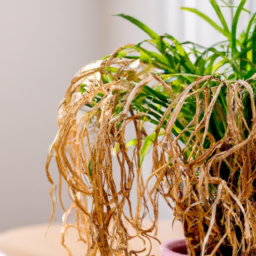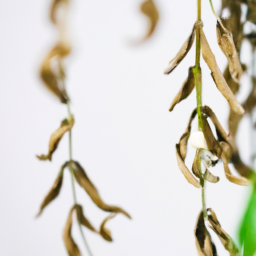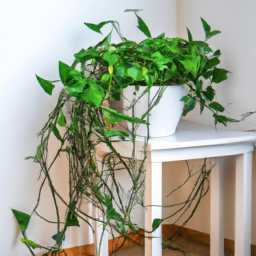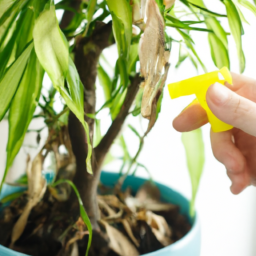
Are your plants looking a little sad and droopy? Don’t worry, we’ve got you covered! In this blog post, we will be discussing some helpful tips and fixes for dealing with drooping plants. Whether you’re a seasoned plant parent or just starting out, it’s important to know how to revive and care for your plants when they start to show signs of distress. So, let’s dive in and learn how to bring your drooping plants back to life!
Identifying the Causes of Drooping Plants
Having drooping plants can be disheartening, especially when you’ve put so much effort into caring for them. However, understanding the causes behind drooping plants is the first step towards nursing them back to health. In this guide, we’ll explore the common reasons why plants droop and provide you with effective tips and fixes to revive them.
1. Insufficient Watering
One of the most common reasons for drooping plants is insufficient watering. Plants need water to survive, and when they don’t receive enough, they begin to wilt. The soil may become dry, and the leaves may lose their turgidity. To fix this issue, follow these steps:
First, check the moisture level of the soil by sticking your finger about an inch deep into it. If it feels dry, it’s time to water your plant. However, avoid overwatering as it can lead to root rot.
When watering, ensure that the water reaches the root zone. Watering the leaves or flowers may not provide the necessary hydration to the plant. Use a watering can or a hose with a gentle spray attachment to water the soil around the base of the plant.
Remember to water your plants consistently, but also consider the specific watering needs of each plant species. Some plants prefer drier conditions, while others thrive in moist soil. Research the watering requirements of your specific plants to avoid under or overwatering.
2. Lack of Sunlight
Another common cause of drooping plants is insufficient sunlight. Sunlight is essential for photosynthesis, the process through which plants convert light into energy. Without enough sunlight, plants may become weak and droop. Here’s how you can address this issue:
Identify the light requirements of your plants. Some plants thrive in full sun, while others prefer partial shade. Observe the location where your plants are currently placed and determine if it receives adequate sunlight based on their needs.
If your plants are not receiving enough sunlight, consider moving them to a brighter spot. Place them near a window or in an area where they can receive indirect sunlight for several hours a day. Alternatively, you can use artificial grow lights to supplement the natural light.
Keep in mind that too much direct sunlight can also harm certain plants. If you notice signs of sunburn or leaf scorch, provide some shade or filter the sunlight using sheer curtains or blinds.
3. Nutrient Deficiencies
Plants require a balanced diet of essential nutrients to grow and thrive. When they lack certain nutrients, they may exhibit signs of drooping. Here’s how you can address nutrient deficiencies:
Identify the specific nutrient(s) your plant may be lacking. Common nutrient deficiencies include nitrogen, phosphorus, and potassium. Look for specific symptoms such as yellowing leaves, stunted growth, or discoloration to determine the nutrient deficiency.
Choose an appropriate fertilizer that provides the necessary nutrients. There are various types of fertilizers available, including organic and synthetic options. Read the instructions carefully and apply the fertilizer according to the recommended dosage for your specific plant.
Avoid over-fertilizing, as it can lead to nutrient burn and further damage your plants. Follow the recommended application frequency and adjust based on the specific needs of your plants.
Regularly monitor your plants’ nutrient levels and adjust the fertilizer application as needed. Some plants may have higher nutrient requirements during certain growth stages, so be mindful of their changing needs.
By addressing these common causes of drooping plants, you can help your green friends regain their vitality. Remember to observe your plants closely, provide appropriate care, and make adjustments as necessary. With patience and proper attention, your drooping plants will soon be thriving once again!

Effective Strategies for Reviving Drooping Plants
Welcome to our comprehensive guide on dealing with drooping plants. Whether you’re a seasoned gardener or just starting out, it can be disheartening to see your beloved plants wilting and drooping. But fear not! With the right strategies and some tender care, you can revive your drooping plants and bring them back to their former glory. In this article, we will explore effective tips and fixes to help you save your plants and ensure their long-term health.
Understanding the Causes of Drooping Plants
Before we dive into the strategies for reviving drooping plants, it’s essential to understand the underlying causes. Drooping plants are often a sign of stress or poor health. Here are a few common reasons why your plants may be drooping:
1. Watering Issues: Overwatering or underwatering can both lead to drooping plants. It’s crucial to find the right balance and ensure your plants receive adequate moisture without drowning their roots.
2. Lack of Sunlight: Plants need sunlight to carry out photosynthesis, the process that provides them with energy. Insufficient sunlight can weaken plants and cause them to droop.
3. Nutrient Deficiencies: Plants require a balanced supply of nutrients to thrive. If they lack essential nutrients like nitrogen, phosphorus, or potassium, they may exhibit drooping symptoms.
4. Temperature Extremes: Extreme temperatures, whether too hot or too cold, can stress plants and cause them to droop. It’s important to provide a suitable environment for your plants to thrive.
Reviving Drooping Plants: Step-by-Step Guide
Now that we have a better understanding of the causes, let’s explore effective strategies for reviving drooping plants:
1. Assess the Watering Needs
Start by checking the soil moisture level. Stick your finger about an inch into the soil near the plant’s base. If it feels dry, it’s time to water. However, if it feels excessively wet, your plant may be suffering from overwatering.
If you suspect overwatering, gently remove the plant from its pot and examine the roots. Trim any mushy or rotten roots and repot the plant in fresh, well-draining soil. Allow the plant to dry out before watering again, ensuring you provide water only when the top inch of soil feels dry to the touch.
If underwatering is the issue, thoroughly water the plant until you see water draining from the bottom of the pot. Repeat this process whenever the soil feels dry to ensure your plant receives adequate hydration.
2. Adjust Sunlight Exposure
If your plant is not receiving enough sunlight, consider relocating it to a brighter spot. Most plants require at least six hours of direct sunlight each day. If you’re unable to provide natural sunlight, consider using artificial grow lights to supplement the plant’s light requirements.
On the other hand, if your plant is exposed to direct sunlight for extended periods, it may be suffering from sunburn. Move the plant to a shadier area or provide some shade using a sheer curtain or shade cloth.
3. Address Nutrient Deficiencies
Feed your plants with a balanced fertilizer to address any nutrient deficiencies. Look for fertilizers specifically formulated for your plant type, as different plants have varying nutrient requirements.
Before applying fertilizer, ensure the soil is moist. Follow the package instructions for the appropriate dosage and frequency. Overfertilizing can lead to fertilizer burn and further stress your plants.
Additionally, consider adding organic matter, such as compost, to improve the soil’s nutrient content and overall health.
4. Create an Ideal Temperature Environment
Ensure your plants are kept in a suitable temperature range. Most indoor plants prefer temperatures between 60-75°F (15-24°C). Avoid exposing them to drafts or extreme temperature fluctuations.
If your plants are outdoors, provide shade during scorching hot days and protect them from frost during colder months. Consider using mulch to regulate soil temperature and retain moisture.
Regularly monitor the temperature and make adjustments as needed to create a favorable environment for your plants to thrive.
5. Prune and Provide Support
If your drooping plant has weak or damaged stems, pruning can help redirect energy to healthier parts of the plant. Remove any dead or yellowing leaves, as they can contribute to stress and disease.
For tall plants that are drooping under their weight, provide support using stakes or trellises. This will help them regain their upright posture and prevent further drooping.
Remember to use clean and sharp pruning tools to avoid introducing infections. Disinfect the tools with rubbing alcohol before and after each use.
By following these strategies and providing the necessary care, you can effectively revive your drooping plants and promote their overall well-being. Remember to be patient, as it may take some time for your plants to recover fully.
We hope this guide has been helpful in addressing your concerns about drooping plants. With proper attention and a little TLC, you’ll soon see your plants thriving again!

Preventive Measures to Avoid Drooping Plants
Having healthy and vibrant plants is the dream of every gardener. However, sometimes plants can start drooping, which can be a sign of various issues. To prevent drooping plants, it is important to understand the common causes and take preventive measures. In this article, we will explore some effective tips and fixes to deal with drooping plants.
1. Proper Watering Techniques
One of the main reasons for drooping plants is improper watering. Overwatering or underwatering can both lead to plant stress and drooping. To prevent this, it is crucial to establish a proper watering routine.
Firstly, always check the moisture level of the soil before watering. Stick your finger about an inch into the soil and if it feels dry, it’s time to water. However, if it feels moist, hold off on watering as the plant might still have enough moisture. This simple test can help you avoid overwatering.
Secondly, ensure that you water your plants deeply but infrequently. This encourages the roots to grow deeper, making the plants more resilient and less prone to drooping. Watering deeply also helps to flush out any accumulated salts in the soil, which can be harmful to the plants.
2. Adequate Sunlight and Temperature
Another factor that can cause drooping plants is insufficient sunlight or extreme temperatures. Different plants have varying sunlight and temperature requirements, so it is essential to understand the needs of your specific plants.
Make sure to place your plants in areas that receive the appropriate amount of sunlight. Most plants thrive in bright, indirect light, while some may require direct sunlight. Monitor the amount of sunlight your plants are receiving and adjust their location accordingly.
Similarly, extreme temperatures can stress plants and cause them to droop. Avoid placing your plants near drafty windows, heating vents, or air conditioning units. Maintain a consistent temperature range suitable for your plants to prevent drooping.
3. Proper Nutrient Balance
Providing your plants with the right nutrients is crucial for their overall health and to prevent drooping. Different plants have different nutrient requirements, so it is important to use the appropriate fertilizer and follow the recommended feeding schedule.
Before fertilizing, test the soil to determine its pH level and nutrient deficiencies. This will help you choose the right fertilizer and ensure a proper nutrient balance. Over-fertilizing can be just as harmful as under-fertilizing, so always follow the instructions on the fertilizer packaging.
In addition to regular fertilization, consider using organic matter such as compost or mulch to improve the soil structure and provide a steady release of nutrients. This can help prevent nutrient imbalances and keep your plants healthy and upright.
In conclusion, preventing drooping plants requires a proactive approach and attention to their specific needs. By following proper watering techniques, providing adequate sunlight and temperature, and maintaining a proper nutrient balance, you can keep your plants healthy and prevent drooping. Remember to regularly monitor your plants, observe any changes, and take prompt action to address any issues that may arise. With these preventive measures in place, you can enjoy beautiful, upright plants all year round.
Here’s the Summary Snapshot
Have you noticed your beloved houseplants looking a bit sad lately? Drooping leaves and wilted stems can be a cause for concern, but fear not! There are several easy tips and fixes to help bring your plants back to their vibrant and healthy selves.
Firstly, it’s important to identify the cause of the drooping. Overwatering is a common culprit, as it can lead to root rot and hinder the plant’s ability to absorb nutrients. To remedy this, allow the soil to dry out between waterings and ensure proper drainage. On the other hand, underwatering can also cause plants to droop. Check the moisture levels regularly and adjust your watering schedule accordingly.
Another factor to consider is lighting. Plants need adequate sunlight to thrive, so ensure they are placed in a spot with the right amount of light for their specific needs. If your plant is not getting enough light, it may become weak and droopy. Consider moving it to a brighter location or providing artificial light if necessary.
Nutrient deficiencies can also cause drooping plants. Fertilize your plants regularly, following the instructions on the packaging. This will provide them with the necessary nutrients to stay healthy and strong. Additionally, make sure your plants are in the appropriate temperature and humidity levels. Extreme temperatures or dry air can cause stress and lead to drooping.
Lastly, don’t forget to inspect your plants for any signs of pests or diseases. Insects like aphids or spider mites can damage plants and cause them to droop. Treat affected plants with organic pest control methods or consult a professional if needed.
By following these simple tips and fixes, you can help your drooping plants regain their vitality and beauty. Remember, a little care and attention go a long way in keeping your indoor garden thriving!
Curious Minds Asked, We Responded. Frequently Asked Questions:
Q1: Why are my plants drooping?
A1: There are several reasons why plants may droop. One common cause is underwatering, which can lead to dehydration and wilting. Overwatering, on the other hand, can cause root rot and lead to drooping. Other factors such as insufficient sunlight, nutrient deficiencies, pests, or diseases can also cause plants to droop.
Q2: How can I revive a drooping plant?
A2: To revive a drooping plant, start by assessing its watering needs. If the soil feels dry, give it a thorough watering and make sure excess water drains properly. If overwatering is the issue, allow the soil to dry out before watering again. Ensure the plant receives adequate sunlight and consider fertilizing it with a balanced plant food. If pests or diseases are suspected, take appropriate measures to control them.
Q3: How can I prevent my plants from drooping?
A3: Preventing drooping plants involves proper care and maintenance. Be sure to water your plants regularly, but avoid overwatering. Ensure they receive the right amount of sunlight based on their specific needs. Fertilize them appropriately to provide essential nutrients. Regularly inspect your plants for signs of pests or diseases and take prompt action if any are detected. Additionally, ensure proper air circulation around the plants.
Q4: Can repotting help with drooping plants?
A4: Yes, repotting can sometimes help revive drooping plants. If the plant is rootbound or the soil has become compacted, repotting it into a larger container with fresh, well-draining soil can provide it with the necessary space and nutrients for growth. However, be cautious not to damage the plant’s roots during the repotting process.
Q5: Are there any specific plants that are prone to drooping?
A5: While any plant can droop under unfavorable conditions, some plants are more prone to drooping than others. For example, plants with large leaves, such as peace lilies or calatheas, may droop more noticeably when they lack water. Similarly, certain plants like snake plants or succulents are adapted to survive in dry conditions and may droop if overwatered. It’s important to research the specific needs of your plants to understand their tendencies and provide appropriate care.

Lisa Chen is a seasoned indoor gardening expert and the author of several bestselling books on the topic. With a background in horticulture and urban farming, Lisa is dedicated to helping urban dwellers embrace the joys of cultivating green spaces indoors. Her detailed guides and hands-on tips empower readers to transform their living spaces into thriving plant sanctuaries.


